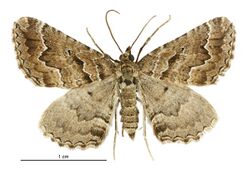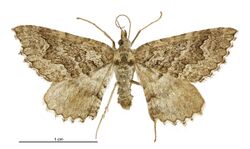Biology:Austrocidaria lithurga
| Austrocidaria lithurga | |
|---|---|

| |
| Male | |

| |
| Female | |
| Scientific classification | |
| Kingdom: | |
| Phylum: | |
| Class: | |
| Order: | |
| Family: | |
| Tribe: | |
| Genus: | |
| Species: | A. lithurga
|
| Binomial name | |
| Austrocidaria lithurga (Meyrick, 1911)[1]
| |
| Synonyms | |
| |
Austrocidaria lithurga is a species of moth in the family Geometridae. It is endemic to New Zealand. This moth is classified as at risk, naturally uncommon by the Department of Conservation.
Taxonomy
This species was first described by Edward Meyrick in 1911 and named Hydriomena lithurga.[2][3] Meyrick used a specimen obtained from R. M. Sunley who had collected a pupa from a Muehlenbeckia plant at Mākara Beach, Wellington, in November and had raised the adult in captivity.[3] George Hudson described and illustrated the species in his 1928 book The Butterflies and Moths of New Zealand.[4] In 1971 John S. Dugdale assigned H. lithurga to the genus Austrocidaria.[5] Dugdale postulated that A. lithurga might prove synonymous with Austrocidaria prionota.[5]
The holotype specimen is held at the Natural History Museum, London.[2]
Description
Meyrick originally described this species as follows:
♂︎. 25 mm. Head and thorax pale greyish-ochreous mixed with whitish, transversely barred with blackish-grey suffusion. Palpi 1 1⁄2, blackish-grey, lower longitudinal half whitish. Antennae somewhat stout, shortly ciliated (1⁄3). Abdomen pale greyish-ochreous, mixed on sides with dark grey and whitish, segmental margins white preceded by a black mark on each side of back. Forewings triangular, costa rather strongly arched towards apex, apex obtuse, termen rather obliquely rounded, crenate; pale greyish-ochreous, marked with indistinct waved striae of grey irroration becoming blackish on costa; margin of a small basal patch indicated on lower half by a blackish stria edged with white posteriorly; median band formed by two fasciae of several rather irregular suffused grey striae each, well marked except beneath costa, margins marked with black edged exteriorly with white except near costa, anterior margin twice sinuate, posterior with median third forming a rather strong subtriangular obliquely bilobate prominence; a transverse-linear black slightly whitish-edged discal dot on anterior of these fasciae; subterminal line of ground-colour, slender, strongly waved, preceded by some grey suffusion towards dorsum and above middle, and cut by an oblique dark-grey streak from apex marked with blackish; a fine black terminal line: cilia whitish with two grey shades, with undefined dark-grey bars. Hindwings with termen rounded, crenate; grey- whitish, median band and subtei-minal line indicated by faint grey striae obsolete towards costa; a blackish-grey linear discal dot; cilia as in forewings, but dark markings nearly obsolete round apex.[3]
Distribution
This species is endemic to New Zealand.[1] This species range is Wellington and Mid Canterbury.[6] As well as the type locality, this species is recorded as having been collected at Sinclair Head and at Baring Head, both in Wellington.[4][7] It has also been located in south Marlborough.[8] It is possible that the species is also present at Little Bush, Puketitiri, in the Hawkes Bay.[9]
Biology and life cycle
The pupa of this species is attached to a loose cocoon.[3] The adult moth is on the wing in October and November.[4][10]
Host species and habitat
Hudson hypothesised that the host plants of the larvae of this moth are Muehlenbeckia species[4] and it has also been suggested that the host plants are divaricating small-leaved Coprosma species.[6] However the precise host species for this moth is unknown as is its preferred habitat but it has been hypothesised that A. tithurga prefers open shrub-land.[8]
Conservation status
This moth is classified under the New Zealand Threat Classification System as being at risk, naturally uncommon.[11]
References
- ↑ 1.0 1.1 Gordon, Dennis P., ed (2010). New Zealand Inventory of Biodiversity. Volume two. Kingdom Animalia: Chaetognatha, Ecdysozoa, Ichnofossils. 2. Christchurch, N.Z.: Canterbury University Press. pp. 459. ISBN 9781877257933. OCLC 973607714.
- ↑ 2.0 2.1 Dugdale, J. S. (1988). "Lepidoptera - annotated catalogue, and keys to family-group taxa". Fauna of New Zealand 14: 175. https://www.landcareresearch.co.nz/__data/assets/pdf_file/0017/26324/FNZ14Dugdale1988.pdf. Retrieved 18 May 2018.
- ↑ 3.0 3.1 3.2 3.3 Meyrick, Edward (1911). "Notes and descriptions of New Zealand Lepidoptera. Parts I and II". Transactions and Proceedings of the New Zealand Institute 43: 57–78. https://biodiversitylibrary.org/page/9782110.
- ↑ 4.0 4.1 4.2 4.3 Hudson, G. V. (1928). The Butterflies and Moths of New Zealand. Wellington: Ferguson & Osborn Ltd.. pp. 114. OCLC 25449322. http://www.bugz.org.nz/WebForms/ResultDetails.aspx?CurrentDoc=C7E94865-492F-45DA-9777-CC8E1E8B1438&back=true&NewDoc=true&searchType=1&SearchString=G.V.+Hudson.
- ↑ 5.0 5.1 Dugdale, J. S. (10 November 1971). "Entomology of the Aucklands and other Islands south of New Zealand: Lepidoptera, excluding non-Crambine Pyralidae". Pacific Insects Monograph 27: 55–172. http://hbs.bishopmuseum.org/pim/pdf/pim27-55.pdf.
- ↑ 6.0 6.1 Patrick, Brian; Dugdale, John S. (2000). Conservation Status of the New Zealand Lepidoptera. Wellington, N.Z.: Department of Conservation, New Zealand. pp. 20. ISBN 0478218672. OCLC 154670803. https://www.doc.govt.nz/documents/science-and-technical/Sfc136.pdf.
- ↑ Crisp, Philippa (2011). "Baring Head ecological values". http://www.gw.govt.nz/assets/Parks-and-Recreation/East-Harbour/Baring-Head-redevelopment-reference-material/Biodiversity-and-landscape/Baring-Head-Ecological-Values-Report.pdf.
- ↑ 8.0 8.1 Crown Pastoral Land Tenure Review. Glenlee Run. Conservation Resources Report. (Report). Land Information New Zealand. 2016. pp. 1–74. https://www.linz.govt.nz/system/files_force/media/doc/cp_glenlee-run-conservation-resources-report_20170629.pdf?download=1. Retrieved 19 May 2018.
- ↑ Keesing, Vaughan (6 May 2012). "Appendix XV. Peer-Review Letter and Response to Peer-Review Letter. Ecological Review of the Terrestrial Ecological AEE Prepared for the Hawke's Bay Regional Council Ruataniwha Water Storage Project". https://www.hbrc.govt.nz/assets/Document-Library/RWSS-Final-RMA-Reports/Assessment-Reports/RWSS-A4-Terrestrial-Ecology-Assessment-Volume-II-Kesssels-and-Associates-May-2013-Part-C.pdf.
- ↑ Pawson, S. M. (2000). "The conservation status of invertebrates in Canterbury". https://www.researchgate.net/publication/43125681.
- ↑ Hoare, R.J.B.; Dugdale, J.S.; Edwards, E.D.; Gibbs, G.W.; Patrick, B.H.; Hitchmough, R.A.; Rolfe, J.R. (2017). Conservation Status of New Zealand Butterflies and Moths (Lepidoptera), 2015. Wellington, New Zealand: New Zealand Department of Conservation. pp. 8. ISBN 9781988514383. http://www.doc.govt.nz/Documents/science-and-technical/nztcs20entire.pdf.
External links
Wikidata ☰ Q13879124 entry
 |

